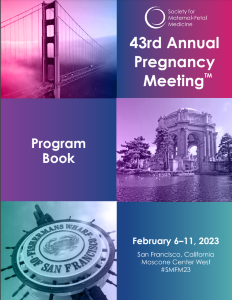Category: Diabetes
Poster Session III
(787) Continuous Glucose Monitoring Use among Female Individuals of Reproductive Age with Type I Diabetes
Optimal glycemic control with type I diabetes (TID) in the periconception period is critical to prevent congenital malformations, miscarriage, and adverse pregnancy outcomes. We identified socio-demographic, clinical, and glycemic-related characteristics associated with continuous glucose monitoring (CGM) in female individuals of reproductive age with T1D.
Study Design: A secondary analysis was performed from the prospective cohort T1D Exchange clinic registry from >80 clinics across the U.S. We included female individuals with T1D aged 15-45 years with data between 2015 to 2018. We assessed socio-demographic (age, education, income, self-reported race and ethnicity), clinical (BMI, insulin delivery, T1D duration, T1D complications), and glycemic-related factors (diabetic ketoacidosis, symptomatic hypoglycemia, and hemoglobin A1c) that were associated with CGM use. Imputation for missing covariates was performed, and multivariable logistic regression was used.
Results: Among 6,643 female individuals of reproductive age with T1D, CGM use increased over time from 2015 to 2018 (20.6% to 30.0%; aOR 2017-2018 vs. 2015-2016: 1.73; 95% CI: 1.52-1.97), and was more likely among those who had been pregnant in the last 12 months (45.3% vs. 25.8%; aOR: 1.72; 95% CI: 1.30-2.27). Socio-demographic characteristics, including non-Hispanic Black and Hispanic race and ethnicity, younger age, lower educational attainment, lower income, and Medicaid insurance were associated with lower odds of CGM use (Table). Conversely, CGM use was associated with lower odds of diabetic ketoacidosis (12.9% vs. 27.2%; aOR: 0.57; 95% CI: 0.41-0.78) and lower hemoglobin A1c (mean: 7.6% vs. 8.6%; aOR: 0.75; 95% CI: 0.71 to 0.79), but a similar likelihood of symptomatic hypoglycemia. CGM use was associated with insulin pump use.
Conclusion:
CGM use has increased over time in female individuals of reproductive age with T1D, and those using CGM have better glycemic control. Most were not using CGM, including during pregnancy, and the likelihood of not using CGM was related to multiple adverse social determinants of health.

Kartik Kailas Venkatesh, MD, PhD (he/him/his)
Assistant Professor
The Ohio State University
Columbus, Ohio, United States- EB
Elizabeth Buschur, MD
Assistant Professor
The Ohio State University Wexner Medical Center
Columbus, Ohio, United States - JW
Jiqiang Wu, MSc
The Ohio State University
Columbus, Ohio, United States 
Camille E. Powe, MD
Assistant Professor
Department of Medicine and Obstetrics and Gynecology, Massachusetts General Hospital
Boston, Massachusetts, United States.jpg)
Mark B. Landon, MD
Richard L. Meiling Professor and Chair, Obstetrics and Gynecology
The Ohio State University
Columbus, Ohio, United States- SG
Steven Gabbe, MD
The Ohio State University Wexner Medical Center
Columbus, Ohio, United States - KG
Kajal Gandhi, DO
The Ohio State University
Columbus, Ohio, United States 
William A. Grobman, MD, MBA
Vice Chair, Clinical Operations, Maternal Fetal Medicine
The Ohio State University
Columbus, Ohio, United States- NF
Naleef Fareed, MBA, PhD
The Ohio State University
Columbus, Ohio, United States

.png)

